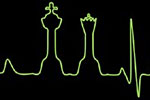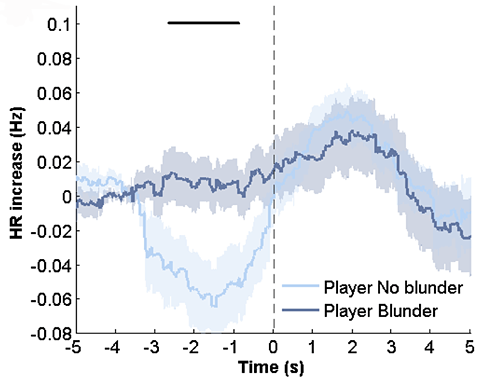The Heart of Chess
By Maria Juliana Leone and Mariano Sigman
Decisions, decisions, decisions…
Deciding is committing to one out of several options. Under very specific circumstances, this process relies on an exhaustive rational deliberation to determine which of all options maximizes a given goal. Instead, the majority of human decisions rely in heuristics, “fast and frugal” solutions fueled by hunches “gut feelings” and intuitions.
One way or the other, approximate or exact, decisions rely on an evaluation function, the goodness of the state resulting from each choice. A main challenge in economy or psychology is how to set this function. When buying a car: how should one weight its price, security, comfort, and aesthetics? It is thus difficult to determine the correctness of a choice. Part of this can be solved by asking people in retrospective about their own satisfaction and use this as a normative measure of the quality of a decision.
In chess this conundrum is solved Solomonicly: the quality of a decision is set by the resulting evaluation function of the position. While there may be some minor debate on this (different programs or players may disagree) this dissonance is extremely small compared to evaluations of real-life decisions. Hence as Garry Kasparov and many others have sometimes suggested, decision-making in chess is a goldmine for understanding and improving our decision-making everywhere else (Kasparov, 2007). In Kasparov words: “… it is due to its limited scope that chess provides such a versatile model for decision-making. There are strict standards of success and failure in chess. If your decisions are faulty your position deteriorates and the pendulum swings towards a loss; if they are good it swings towards a victory. Every single move reflects a decision and, with enough time, it can be analyzed to scientific perfection whether or not each decision was the most effective” (Kasparov, 2007).
Chess, the natural laboratory of human thought
Chess is a formidable vehicle to study human decision because it mimics life on a simplified terrain. Just to summarize:
-
Chess develops in a finite environment (board with 64 and 32 pieces, a clock) allowing a virtually indefinite amount of states (positions) and decision patterns.
-
Players make decisions on a finite time-budget (thus ideal to study speed-accuracy trade-offs).
-
Every decision (move) can be accurately evaluated contrary to real-life where the outcome of a decision is ambiguous.
-
In life there are good decision makers and bad-decision makers, but those are difficult to tell apart. In chess it’s simple. Elo (or online ratings) constitute a formidable estimator of the quality of the decision maker.
-
As beautifully described by Adrian de Groot in his seminal book (de Groot, 1965), players recognize specific events of their inner thinking during the game (like planning, calculation, and error moments), which explains why chess has been a goldmine for studies of introspection, our ability to inquire about our own thoughts.
-
Chess is played in a social setup, promoting friendship, rivalry, all sorts of social emotions which also occur in life.
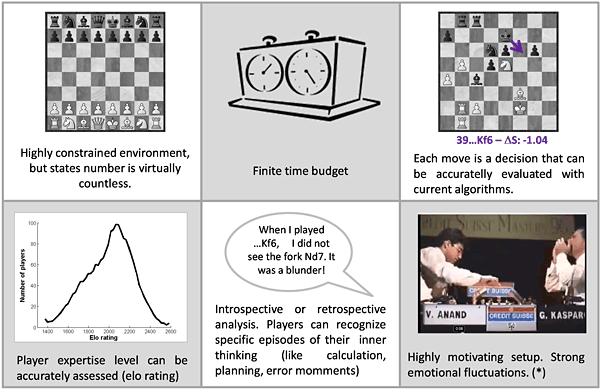
Chess advantages as a decision making model
The tell-tale heart
We recently inquired whether, as in Edgar’s Allan Poe’s short story our hearts might be more verbose than we think, and it only takes to listen to it to understand our reasoning and our thoughts. There is one aspect which is perhaps unsurprising – the outcome of a decision will be revealed in the speed at which our heart beats. Who wouldn’t imagine its heart beating hard after a blunder or in a tense moment of the battle? The other side of this story is more interesting. Can the state of our heart tell us whether we will decide well or wrong? Can the rate of the heart of the player speak about his process of thought, whether he is calculating, planning, or going through a moment of inspiration? We showed that, indeed, the heart can tell much about what has happened, what’s happening and what will happen in our minds. This is more of substantial evidence that decisions rely on intuitions, heuristics which relate to body markers (Damasio, 1994) and gut feelings.

Extracts of heart activity of a subject playing 1 min chess. Heart rate (the inverse of time between heart beats) increases during the game, compared with periods before and after the game.
We recorded the heart beats of chess players (Elo rating 2021-2216 ) while playing 15 minute games, chosen as a compromise to generate move durations which are fast enough to investigate transitions in heart rate but also sufficiently slow to allow a player to retrospectively recall relevant moments perceived and experimented during the game.

Experimental setup. We record heart activity and other physiological variables in a game of chess. Hear rate can then be analyzed relative to specific moves, moments of the games, score of the position, blunders…
After each game, players record retrospectively relevant moments of the game. We asked how heart-rate changes when a player blunders, when the opponent blunders, when a player is planning, under time pressure, in a won position… In other words, we sought to inquire whether the heart is a good dictionary to convey the different states of the game.
Specifically, our aim was to investigate which aspects of heart rate index objective variables (the quality of a move, determined by the change in the objective evaluation of the position) and subjective reports such as the conception of a plan or a moment of calculus, reported by the player in an after game recollection of its inner thought.
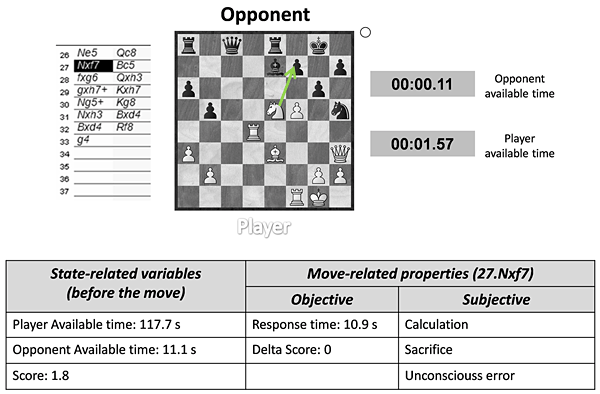
Game variables. A “moment” of the game is defined by the position value and the available times of both players. The player made a move, which has subjective (feeling of thought) and objective (result of the evaluation function)
As most players would guess, heart rate increases as the game advances. Above and beyond this global trend, is heart rate modulated by relevant episodes of the game? From the practical point of view of players, and maybe of all decision makers is “What goes on when we make a mistake?”, “Why is it that we blundered?” and “Does our heart have anything to do with this?”
We analyzed the dynamics of heart rate before or after a blunder (recorded player or opponent). We considered a blunder as a move which decreased the evaluation function in more than one point. As we all know, the blunders are all there on the board, waiting to be made (Savielly Tartakower).
Chess player’s hearts beat faster when the opponent makes a blunder. We may hide it, remain with a completely inexpressive face, but emotions flow and the heart testifies this. This is after all, not surprising.
Player heart rate reacts to opponent blunders. When we plot the player heart rate (HR) fluctuations around blunder or correct opponent moves, we find a different pattern: HR increases after a blunder move, reacting to the opponent error.
The most interesting aspect is the analysis of a player’s blunders compared to correct moves. Here, instead, it is an early deep in heart rate frequency which is absent in blunders. In fact, heart rate frequency a few seconds before the decision is a good classifier (an index, a signature) to tell whether the player will in fact make a mistake. Of course all the complex mechanisms and brain-body interactions are not revealed by this analysis. But robustly, this complex machinery expresses itself in heart rate which acts as a lighthouse of the decision process.
Heart rate on player own moves: blunders versus correct moves. Heart rate (HR) fluctuations locked to the move (time=0 s) are different between blunder and correct player moves. Before the move, HR decreases on correct (no blunder) moves compared to the blunder’s ones.
What about the mechanisms of the decision? Can the heart inform us on whether a move (a decision) resulted from a “Misha Tal-intuitive” sacrifices (heuristic, unconscious hunch, “In my games I have sometimes found a combination intuitively simply feeling that it must be there. Yet I was not able to translate my thought processes into normal human language”) or, instead, a fully calculated line (reducing to its minimal value the role of chance) of Lyova Polugaievsky. What thoughts drove my opponent to make this move? Is he gambling or calculating? Does he have a plan?
The elements of thoughts are rather opaque, not only to our opponent but often to us. Again, we aimed to show, that looking at our own (or opponent) hearts may inform more than we have guessed. And, in fact, this is how it came out. Heart rate increased when a player was calculating or engaged in strategic thinking. Hear the voice of the heart reaches its limits, the signal was insufficient to tell apart one from the other.
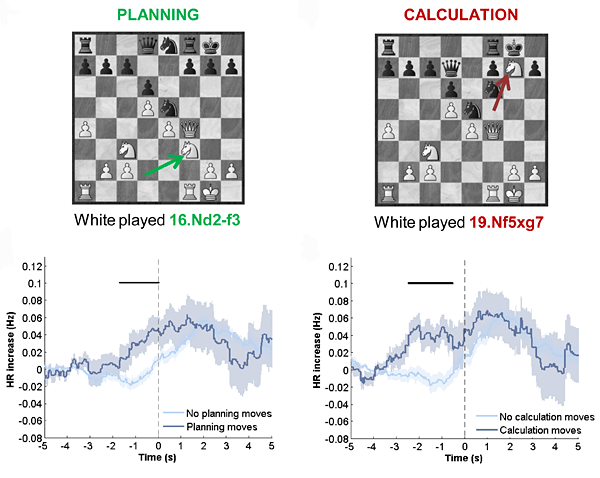
Planning and calculation moves are characterized by heart rate increases before the move. These types of moves showed a similar pattern on heart rate (HR): HR increases before the move. Why? One possibility is that the load of rational thought induces transient increases of HR, which has been previously described in other models. Alternatively, it is possible that somatic changes do not only assist choice in overt actions but also signal internal episodes of a mental program.
The last three figures were originally published in Leone, M. J., Petroni, A., Fernandez Slezak, D., & Sigman, M. (2012). The tell-tale heart: heart rate fluctuations index objective and subjective events during a game of chess. Front Hum Neurosci, 6, 273. doi: 10.3389/fnhum.2012.00273.
Epilogue
Even if HR constitutes a relatively broad marker integrating a myriad of physiological variables, its dynamic was rich enough to reveal relevant episodes of inner thought. Listening to player’s hearts we could show that the heart rate signal carries information capable of indexing these episodes: increasing before player own blunders, planning and calculation moves, and reacting to opponent errors. Hence, in the heat of the battle if you want to know more about your reasoning than what we access by the minute window of introspection you may want to feel your heart. As Blaise Pascal reminds us “Le cœur a ses raisons que la raison ne connaît point.”; the heart has reasons that reason cannot know..
Links
- Leone, M. J., Petroni, A., Fernandez Slezak, D., & Sigman, M. (2012). The tell-tale heart: heart rate fluctuations index objective and subjective events during a game of chess. Front Hum Neurosci, 6, 273. doi: 10.3389/fnhum.2012.00273 [Original paper in pdf]
- Project website
- LNI website

Citations
- Damasio, A. R. (1994). Descartes' Error: Emotion, Reason, and the Human Brain. New York: Grosset/Putnam.
- de Groot, A. (1965). Thought and Choice in Chess. Mounton, The Hague.
- Kasparov, G. (2007). How Life Imitates Chess: Making the Right Moves, from the Board to the Boardroom. New York: Bloomsbury USA.
About the authors
María Juliana Leone was born in Argentina. She got a major in Biotechnology and a PhD in Basic and Applied Sciences, working in Chronobiology at University of Quilmes. Since 2004 she has been teaching Biochemistry in this University. Before starting her degree studies, she played chess in national and international tournaments, obtaining the Woman International Master title in 1999. Before graduating, she worked for a year and a half in the Club Argentino de Ajedrez, where Alekhine beat Capablanca in 1927. After her PhD, she was able to connect her old love (chess) with her work in the Integrative Neuroscience Laboratory, where she currently is doing a postdoc on physiological correlates of decision-making, using chess as a model.
Mariano Sigman was born in Argentina, grew up in Barcelona and came back to Buenos Aires, where he got a major in physics. He moved to New York to do a PhD in neuroscience, focusing on visual perception, on the physiology and psychophysics of perceptual learning. He then moved to Paris, to investigate decision making, consciousness and cognitive architecture. In 2006 he came back (again) to Argentina, as a professor in the Physics Department, where he currently is the director of the Integrative Neuroscience Laboratory. He has very broad interests in cognition including consciousness metacognition and introspection, cognitive development, language and conceptual networks, problem solving, educational neuroscience. He has been awarded the Human Frontiers Science Program and the James S McDonnell Foundation career development awards. He has an extensive career on science popularization, has written hundreds of articles, books, hosts a radio show and participated in several television shows. He is a chess aficionado, a compulsive reader of chess psychology and, unfortunately, a very bad player. He tweets at @mariuchu. Mariano conducted an interview for ChessBase back in 2003.
Copyright Maria Juliana Leone and Mariano Sigman/ChessBase
